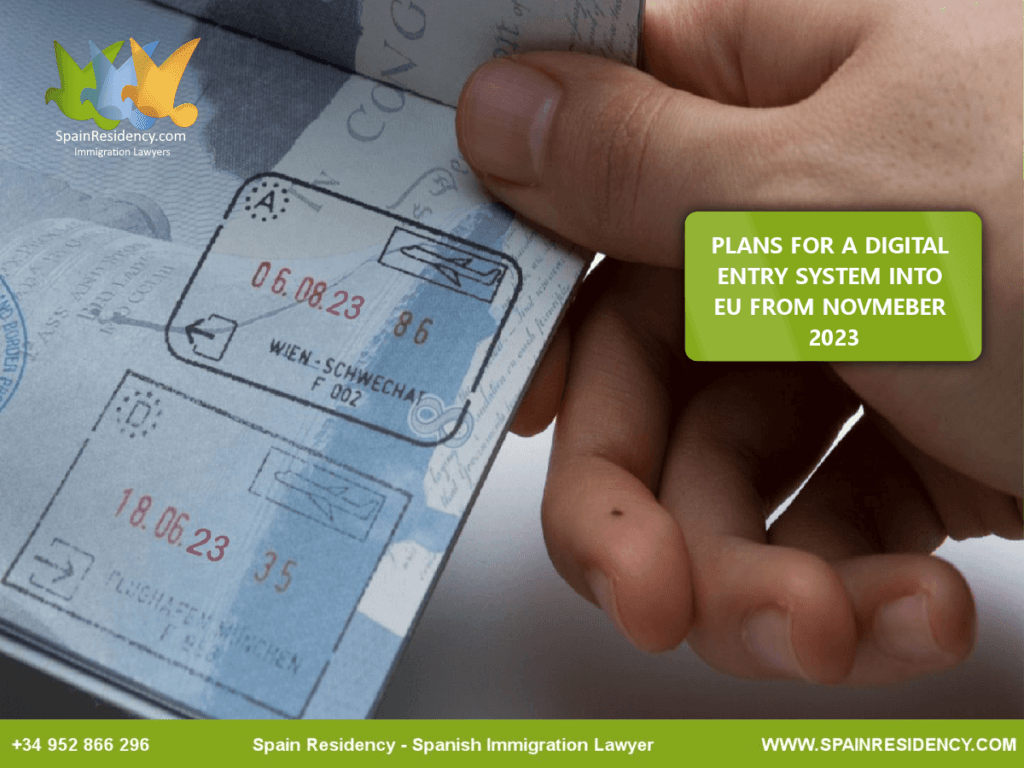Plans for a digital entry system into EU from November 2023 with new facial and fingerprint recognition that will replace traditional stamps.
The manual passport stamping, which is a time-consuming process that lacks overstay detection, is set to evolve in the Schengen Area.
Menu:
In this post we cover the following: (click any section to see its content)
Plans for a digital entry system into EU from November 2023:
DIGITAL ENTRY / EXIT INTO EUROPE:
The Plans for a digital entry system into EU from November 2023, will mean the digital registration for non-EU visitors, including those seeking residency in Spain by preparing for digital entry/exit in Europe from November 2023.
This digital entry system into Europe targets third-country travellers enjoying visa exemptions or holding brief stay visas. Each border crossing will trigger the system’s digital registration, taking down the traveller’s identity, travel document details, biometric data (fingerprints and facial imagery), and the entry/exit chronicle, while also documenting entry refusals and means the EU prepares for digital entry/exit system into Europe from November 2023.
The digital entry/exit system into Europe is anticipated to benefit both EU security and traveller expediency with the system of digital entry/exit system into Europe from November 2023, streamlining border control checks and enabling self-service protocols. However, sectors like the airline industry and certain nations have expressed concerns about the readiness for this transition, and see teething issues.
Initially expected for a 2022 rollout, the system’s implementation was postponed to May 2023, then further extended to November. This delay has raised concerns about the system’s ability to adequately support the surge in travel expected in the coming months, particularly for those seeking residency in Spain and other Schengen countries.
HOW THE SYSTEM WILL WORK:
Under the new EU digital entry/exit system into Europe, visa-free Schengen travellers must secure online travel authorization via the European Travel Information and Authorisation System (ETIAS), introduced in phases following EES initiation. These pivotal changes align with the 90-day limit for non-EU citizens staying in the Schengen Area.
British travelers post-Brexit have received guidance to obtain passport stamps upon Schengen Area entry and exit. This practice substantiates adherence to the 90-day visa-free limit within a 180-day span.
Specifically, the EES will streamline residency in Spain by:
- Providing a more efficient and accurate way to track traveller movements and identify over stayers.
- Reducing the need for manual passport stamping, freeing up border control staff to focus on other tasks.
- Enabling self-service kiosks for passport control, giving travellers more control over their travel experience.
- Facilitating data sharing between Schengen member states, improving coordination and security.
Overall, the EES is a significant modernization of the Schengen Area’s border control system that is expected to benefit both travellers and security.
ALL TYPES OF RESIDENCY AVAILABLE IN SPAIN:
- Golden-Visa Spain (Spain citizenship by investment)
- Non-Lucrative visa Spain (Spain visa non lucrative)
- Self-Employed visa Spain (self employed expats in Spain)
- Digital-Nomad visa Spain (remote worker in Spain)
Please see-here our video-blog with options and legal-advice to obtain residency in Spain.
DIGITAL ENTRY INTO EUROPE FROM NOVMEBER 2023:
Do you need legal assistance in Spain?
We are a Spanish Solicitor and assist our clients with all types of residency applications.
Permanent residency is obtained after 5 years of Spanish Residency through Self-Employed Residency, Digital-Nomad, Non-Lucrative Residency or Golden-Visa. This followed by 5 years as a permanent resident in Spain and means you can then obtain Spanish Citizenship with a Spanish Passport.




